Container gardening – 10 steps to growing plants in pots and ideas to make them look gorgeous
A beginner's guide to growing plants, vegetables, herbs and more in pots – for spaces big and small
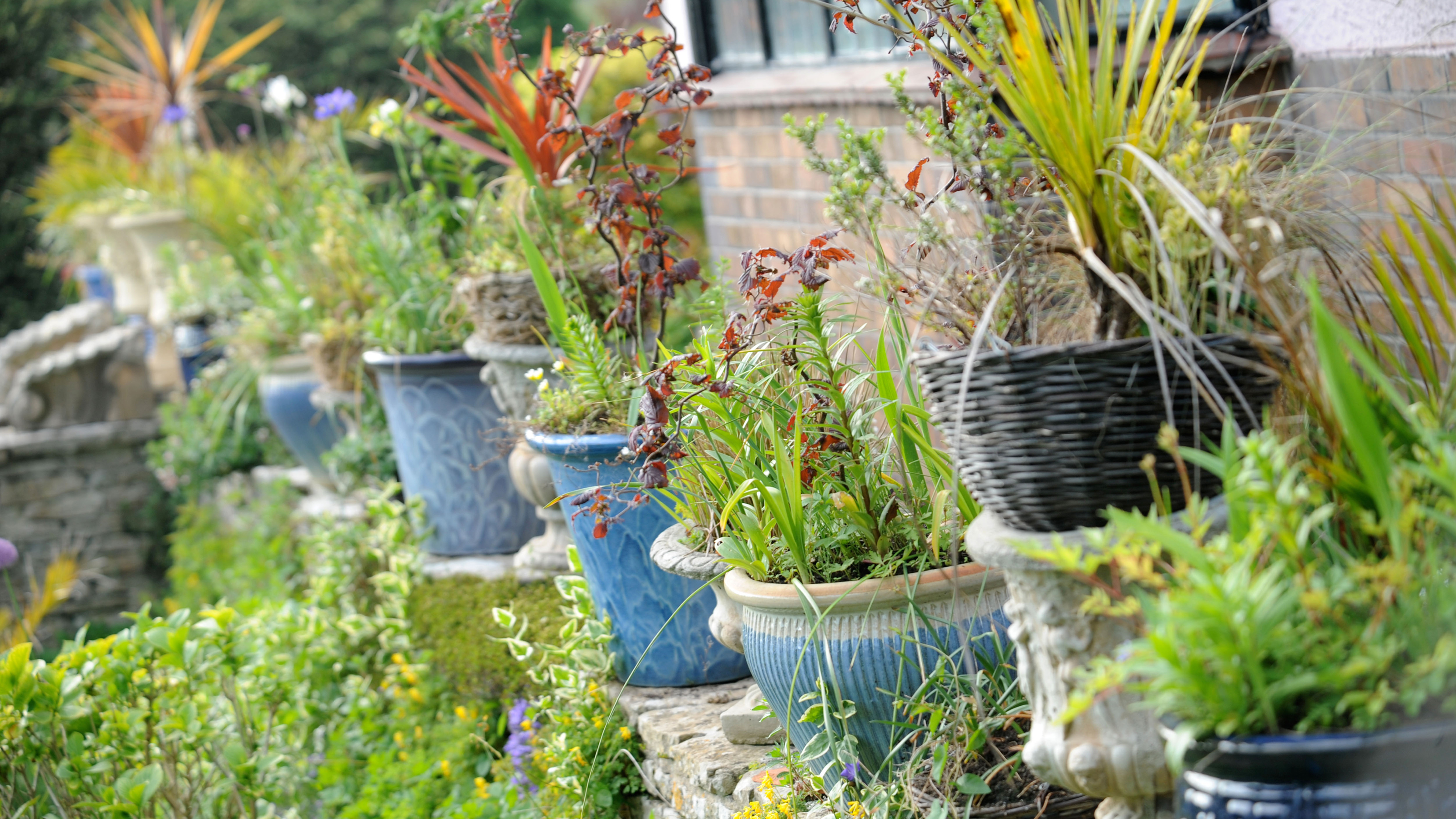
Container gardening is every wannabe green-fingered person's best friend. Especially if you have a small garden or hardly any outdoor space in which to grow vegetables, flowers, herbs, and even trees.
Letting you pot up delicious edibles or decorative plants to enjoy throughout the year, container gardens aren't just one of the most useful garden ideas going, but they are also simpler to care for and far easier to move, than say an entire garden border or vegetable plot, if you rent your property or are looking to move in the future. They are perfect for the balcony gardener.

Further perks of plants in pots include the fact that they can each be moved around to suit their needs and that it's far easier to keep pesky weeds at bay too. Shady plants that are spring-flowering can be given the pride of place when they are performing, while tall pots filled with compact summer annuals can be used cleverly in the middle of garden borders to fill any seasonal gaps.
Tender, even sub-tropical, plants can be placed outside for the summer, where they are more likely to stay healthy and pest-free. They can then be moved back indoors for winter.
You can also better cater to each individual plant's needs as altering soil conditions in each separate pot is easily done in containers, but would be impossible in a garden. This means you can fathom even more creative and exotic displays, displaying and combining plants in pots next to each other with a far better chance of survival. For example, you can place pots of lime-lovers, such as dianthus (pinks) alongside lime-haters, such as skimmia and rhododendron species, or bog plants next to dry habitat species.
But perhaps best of all, container gardening is wonderfully compatible with gardening for beginners. You don't need advanced gardening skills to grow a gorgeous garden in containers – you just need to follow a few simple steps.
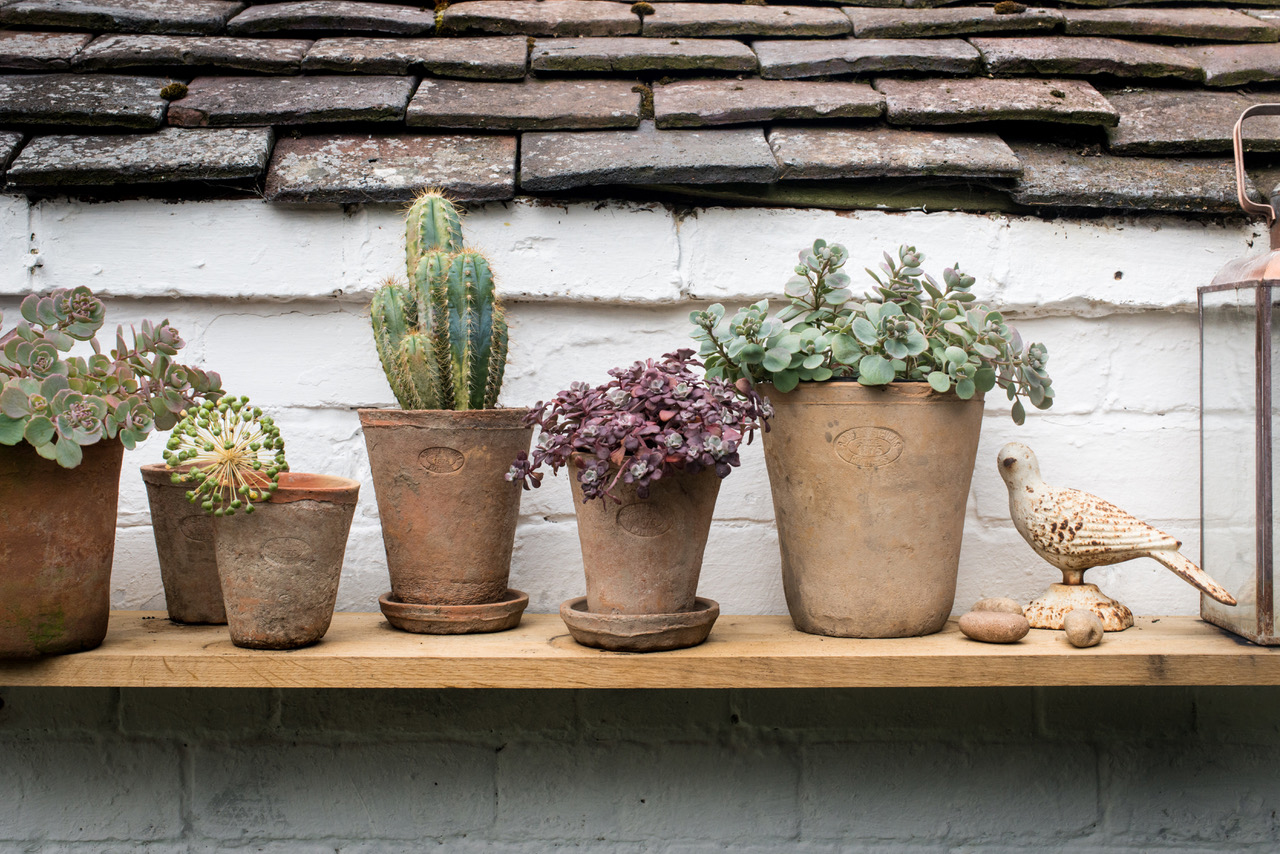
What are the best plants to put in pots?
Many gardeners use gardening containers, pots, and planters for seasonal plants, such as bulbs in spring, colorful bedding in summer, and grasses or foliage plants through autumn and winter. Container gardening allows you to ring the changes year on year, trying out different combinations, alternative color themes, and a range of plant varieties.
Get small space home decor ideas, celeb inspiration, DIY tips and more, straight to your inbox!
We're big fans of container gardening vegetables and herbs in particular. Not only is it of course, deliciously rewarding, but it's also so darn decorative whether you have them growing on a small balcony or in a comically tiny garden space. When the likes of broad beans, courgettes, and basil flower for the most part of their season, you get to enjoy the produce and the free garden decor.
Experiment with container gardening. Use pots to assess the success of various plant combinations. Try something new, change it immediately if it does not work, or give it a few weeks and then alter the arrangement if necessary.
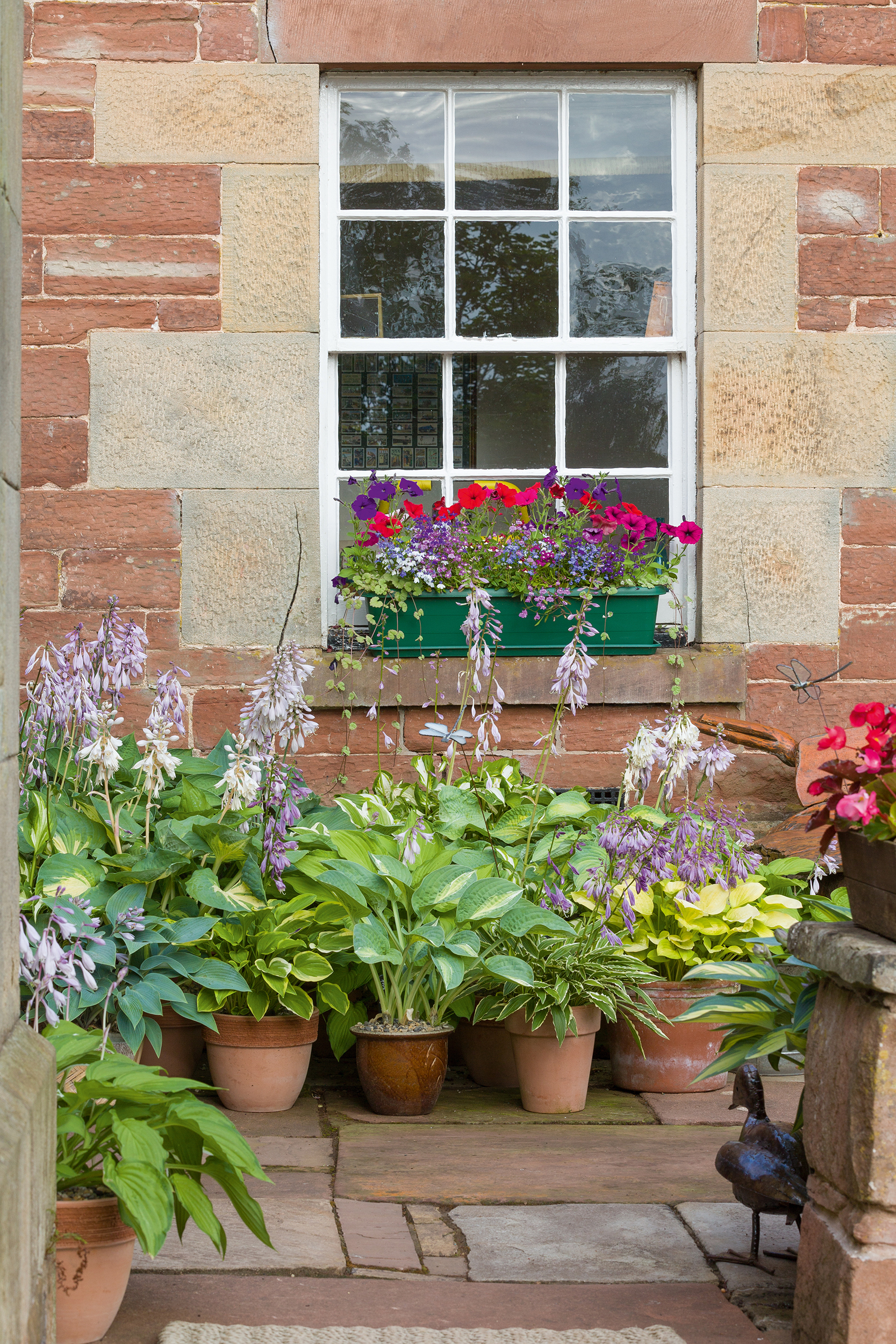
How to start container gardening
Cinead McTernan, author of City Veg: Inspiration from an Urban Garden, available on Amazon, says: 'I would encourage everyone to add containers, whatever their shape, to their garden, windowsill or balcony. The trick to successful container growing is being realistic about which plants you can grow in them and how they need to be looked after – namely feeding and watering during the growing months. Container-grown plants aren’t able to put down their roots to reach a natural water source and the level of nutrients and minerals, which are in abundance as a result of the natural life cycles of the soil, are eventually depleted in a container unless we replenish them.'
1. Choose the right location for your container garden

Where do you have space or where do you want to make space for your container garden? It's vital to know more or less exactly where you want to see the fruits of your labour so that you can get an understanding of the light levels and protectiveness of the zone. This will help determine the plants you can grow and the pots you need for the best success rate.
South- or west-facing spots will suit plants that need a lot of light – think tomatoes, lettuce, kale, lavender and so on – while a shaded location will be fine to house shade plants like Foxglove, Begonias and Hostas. If you can't find a sheltered spot you'll want to think about choosing hardy plants.
2. Choosing your container material type

The wide array of garden containers on the market offers something for every size and style of outdoor space. Before you begin wondering what you need for a container garden, think about what you want from it too. This will help with everything from plant selection to picking the best pots and display ideas.
When choosing the best pots for your plants, consider both the plants needs and the finished look that you want to achieve in your space. And, if you're in need of budget garden ideas in particular, that won't mean you'll have to compromise on style at all.
Terracotta, stone and lead imitations of historic models will make life much easier and cheaper, especially if you want to evoke a classical look in your garden or on a terrace. These types of pots are lighter and therefore safer if you are creating displays for a balcony or a roof garden design.
Bear in mind that terracotta pots dry out very quickly, so it's essential to water plants in terracotta pots even more frequently than other containers.
You can also keep costs down by opting for vintage finds for both effortless style and function. All sorts of items can be reused as containers, think old metal buckets, drainage pipes, bulk food containers, oil cans and more. Just remember to drill drainage holes in the bottom of your vessels to ensure your plants don’t get waterlogged, check that they were not used to hold harmful chemicals in a previous life and clean them thoroughly with hot water and a little mild dish soap to get rid of any pests or disease possibly remaining from old plants. Something to note with metal is that is will conduct heat very quickly so they are best reserved for shady spots to avoid the roots of your plants getting scorched.
Choosing containers made from rustic materials like wood will give a lovely earthy feel to your space and will keep plant roots at a more consistent temperature. It's easy to DIY a planter to make this a cheaper choice, and choosing wood that is naturally rot-resistant such as cedar, teak, and juniper will prolong the life of these containers.
Polyurethane/plastic containers are functional and cheap. They won't chip or crack and they will protect roots against fluctuations in temperature also, making them a sound and easy choice for beginners. Beautify them with basket-like structures made from woven willow or another natural material.
Finally, if you want a polished and modern-looking space, consider containers made from glass fibre, resin, plastic, or wood composite, which imitate natural materials. Note these will be heavier and are usually more expensive but particularly hardwearing.
3. Selecting the best container size
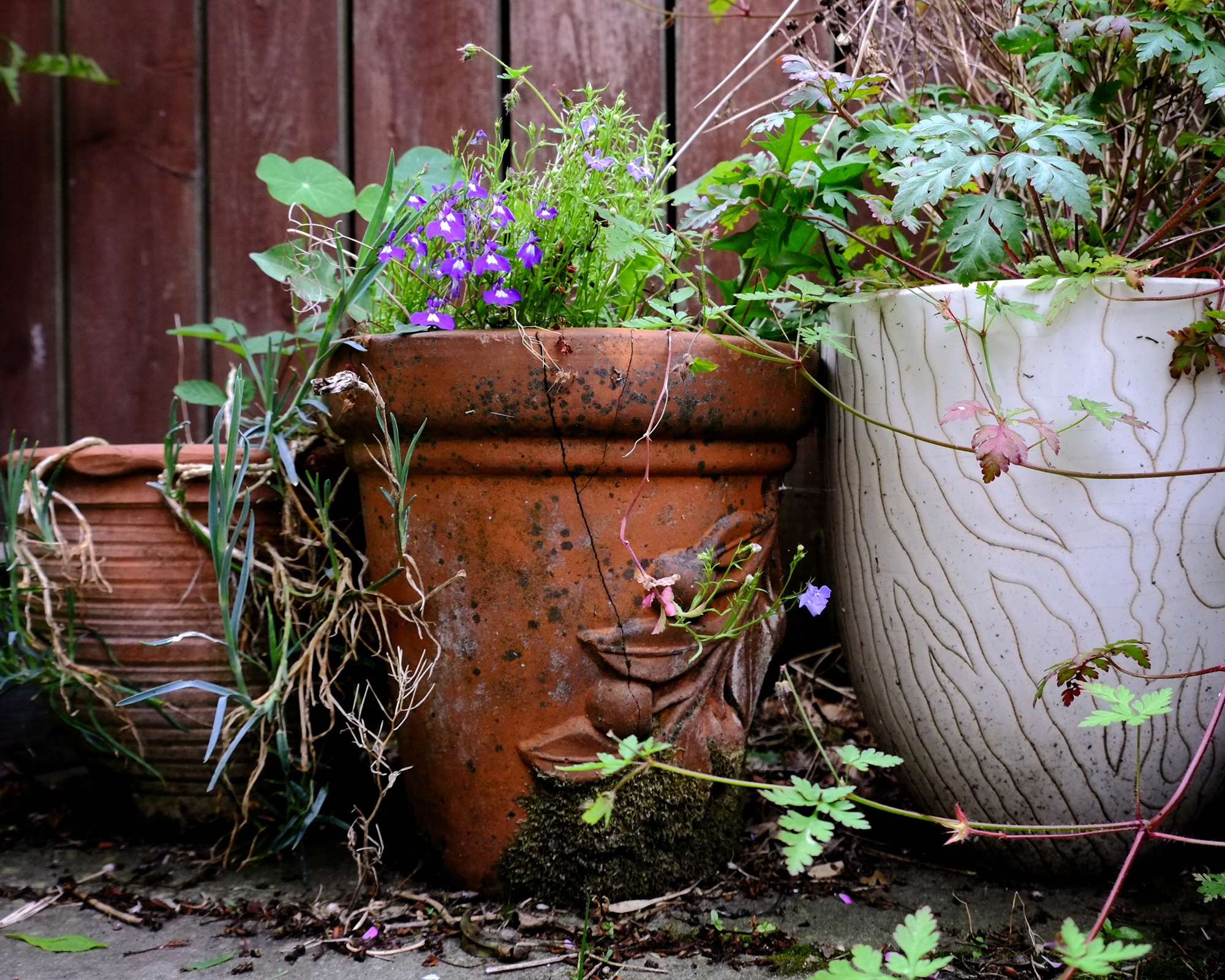
The larger the container, the more compost and moisture it will hold, and therefore the less frequently you will have to water it. If you're working with small backyard ideas, you'll need to be aware of how big a container you physically have room for, but smaller isn't always better.
McTernan says, 'Size also matters, and in my opinion bigger is nearly always better when it comes to container-grown fruit and vegetables – not only because bigger containers hold more soil, which helps maintain moisture levels for longer and prevents temperatures from fluctuating too much during the summer months, but they also provide more space to accommodate roots and ensure there is leeway to add organic matter if required during the growing season.
'Cute, quirky pots are fun for kids and a great way to recycle, but I’m not a fan because in practice, there is often not enough soil for the plants to flourish and there’s also the issue that they dry out very quickly in warmer weather. If you’re not carrying out a daily inspection and they’re deprived of water for too long, the plants will become stressed and unhealthy, and they will ultimately perish.
'There are, of course, drought-tolerant, shallow-rooted plants like thyme and marjoram that will cope better with this treatment (though I’m not encouraging erratic watering). But essentially, it makes sense to choose carefully in the first place – many crops and plants won’t be able to cope in containers that are left to dry out regularly, and if you don’t have time to spend watering every day, small pots are best avoided.
'That said, hanging baskets and window boxes come into their own in so many urban locations, and as long as you’re realistic about what will grow well in them and you’re diligent about watering them, you will be rewarded with eye-catching displays that will produce bountiful harvests.'
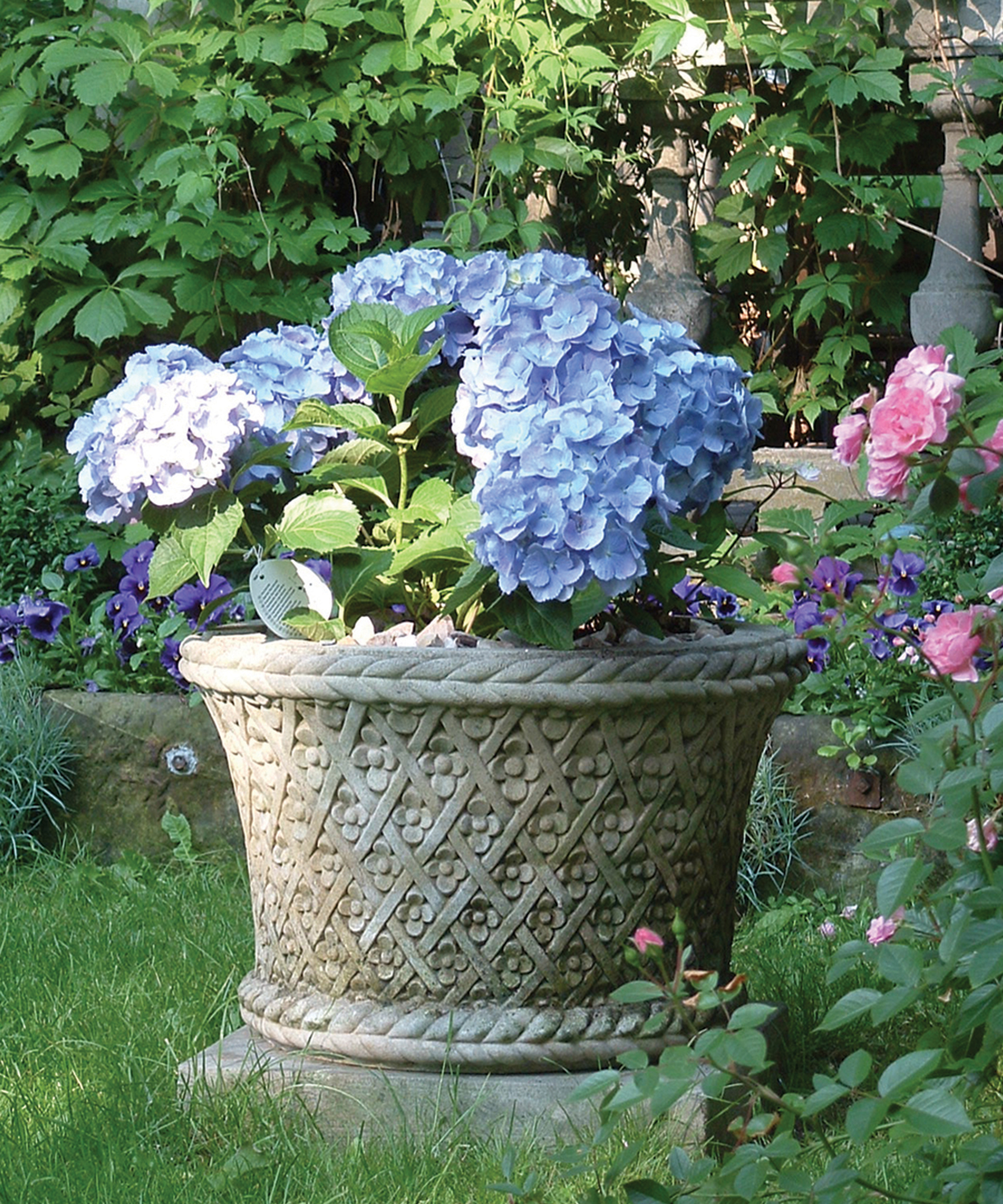
4. Choosing the right shape
Traditional pots, which are wider at the top than the bottom, are perfect for plants, since they provide plenty of space for the roots to grow, and you can remove them easily when you want to re-pot them. A taller pot, which offers even more root room, is vital for some plants and the best choice for many shrubs and climbers, such as roses and clematis.
Plants are more difficult to remove from straight-sided containers, while wall pots with very wide semi-circular tops and narrow bottoms dry out rapidly and are unsuitable for most plants apart from succulents, unless you can water daily in warm or dry weather.
Pots with an incurved top, such as small-necked urns, make it hard to remove established perennial plants without damaging either plants or container; if you like this style, avoid these problems by planting up a small plastic pot that fits snugly into the neck of the urn.
Shallow garden containers that are less than 20cm in height provide a restricted area for rooting and are prone to drying out. They are only suitable for small plants, but can make decorative garden additions if watered frequently.
A very shallow container with a depth of less than 10cm is traditionally used for growing diminutive alpine plants. Many species, such as varieties of dwarf dianthus, flower in spring, so choose those with evergreen foliage, including sedums, phlox, and sempervivum, for a longer season of interest. They are great for decorating outdoor dining areas.

5. Choosing the right soil
For the best start with pots, research the plant you're growing in case it has particular needs. Otherwise, a multipurpose peat-free compost will suffice to grow most plants.
If you know how to make compost then you're off to a good start. And, if you have a garden available and are container gardening to add interest to a patio or other area of your outdoor space, resist the urge to fill containers with soil from your garden as you'll bring in any weeds which will be a nightmare in the long run.
People often wonder whether to line the bottom of a planter with rocks or gravel, but as long as your soil is lightweight and there are drainage holes in your pot, you won't need to do this.
Bear in mind that some plants have very specific soil requirements. For example, cacti and succulents need a very open, light soil structure, so you're best off buying specialist compost. Others, like azaleas and camellias, require acidic, ericaceous compost. Always read up on the plant you're planning on growing before potting it in all-purpose compost.
6. Choosing the best plants
Choosing plants for your containers is the fun part, whether you're picking contemporary, architectural plants, traditional blooms vegetables or herbs.
Best vegetables for containers
We've had high success rates growing tomatoes, courgettes, broad beans, chillies, peppers, lettuce and more in containers. Size is so important when starting a kitchen garden in pots and never ignore the advice given on seed packets as veggies fighting for room will not be happy.
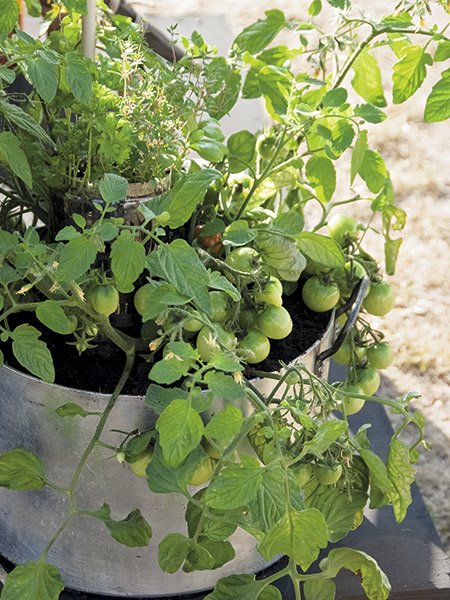
Best herbs for container gardening
Herb-wise, mint is a brilliant choice for containers as it will thrive still, all without taking over your entire garden space! Parsley, coriander, sage and basil are also great additions for your herb garden and they do well in pots.
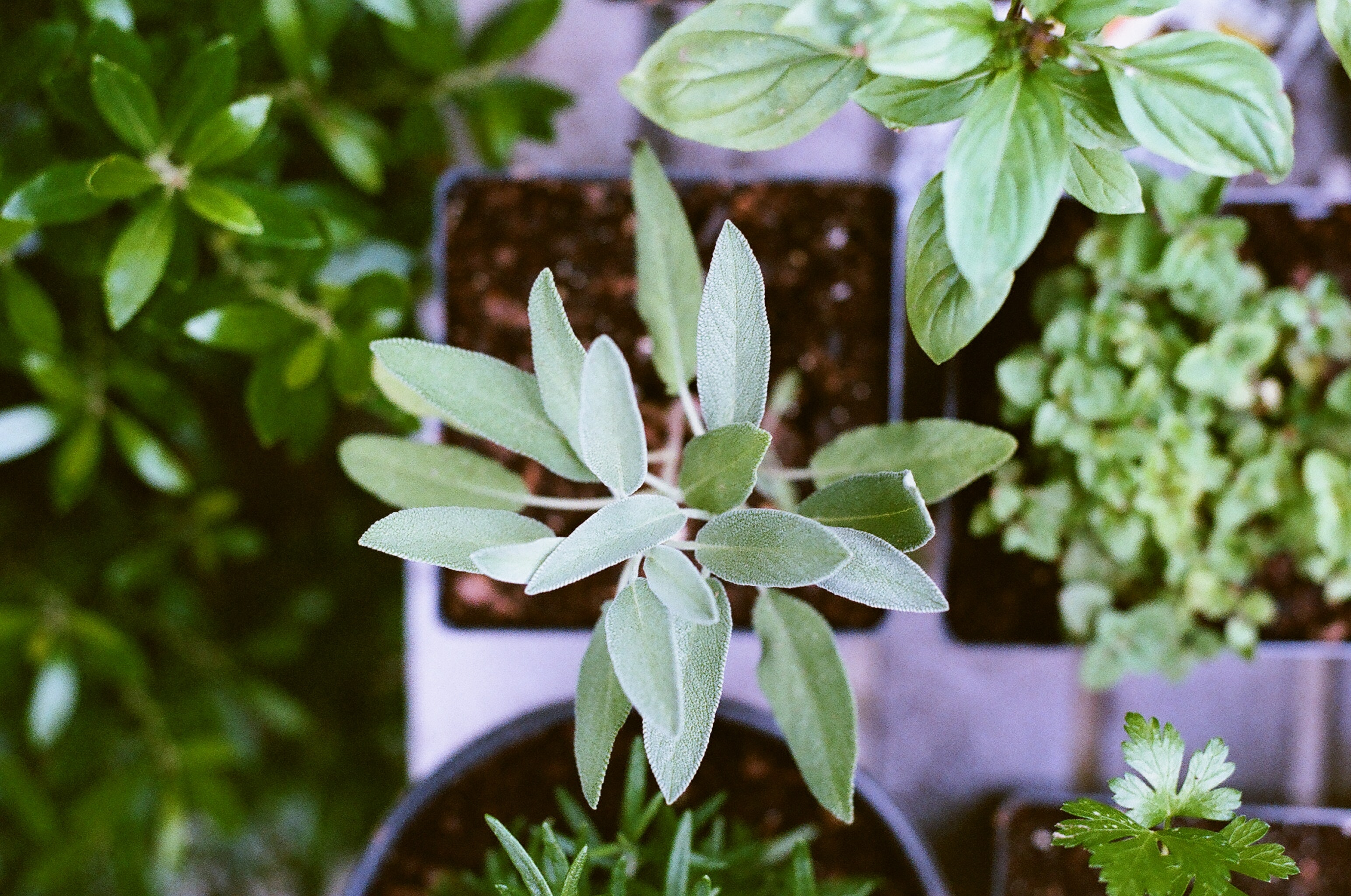
Best plants for shallow containers
Putting pots on a table top? They're likely to be shallow – so plant up Antennaria dioica, Campanula – dwarf forms, e.g. C. cochlearifolia, Delosperma species, Geranium, Phlox subulata, Rhodiola species, Scleranthus species, Sedum – alpine species, Sempervivum species or Veronica prostrata.
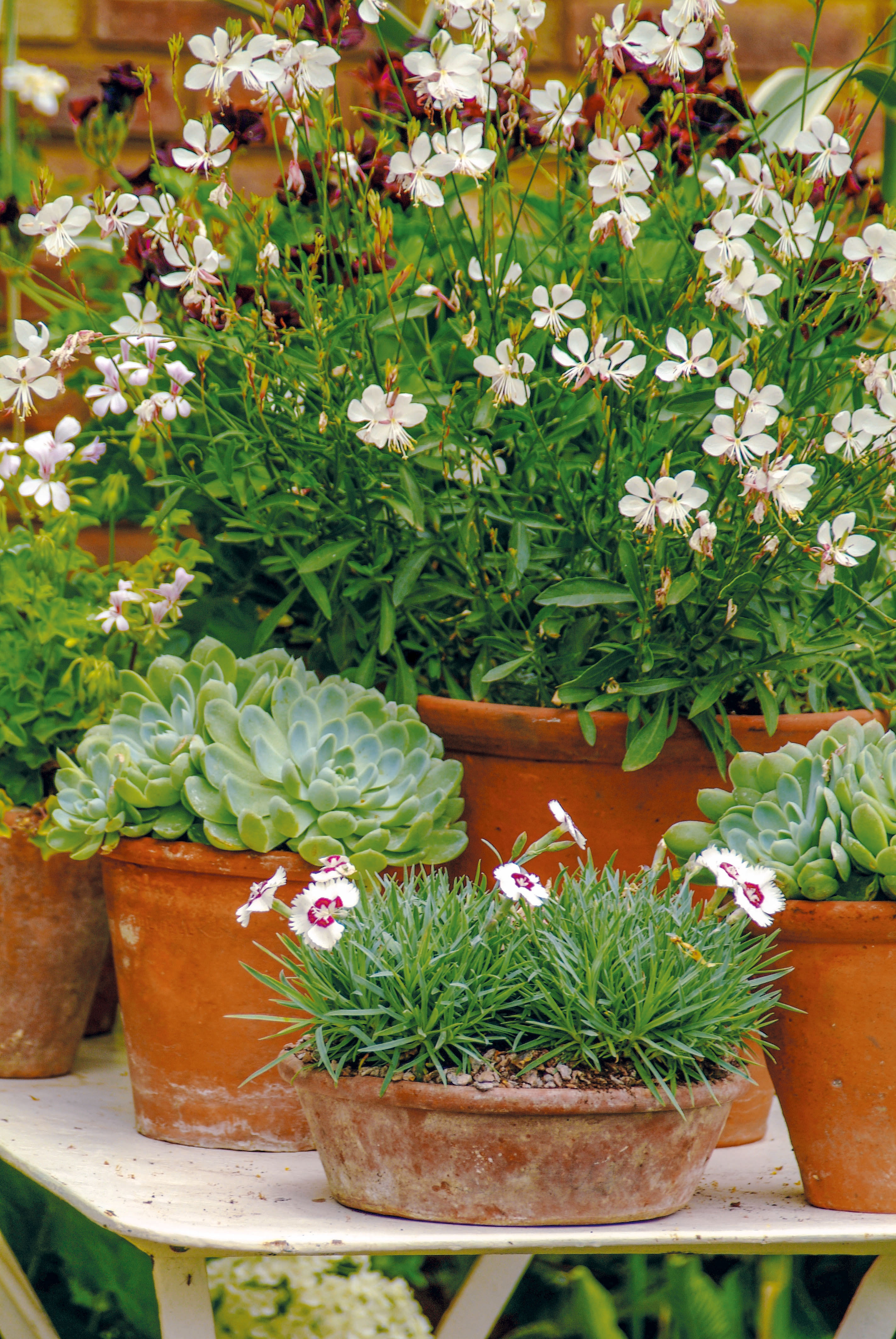
Best climbing plants for pots
Climbing plants can be perfect for container gardening. Our best picks are: Clematis – especially small types – Hedera species, Jasminum species and Trachelospermum jasminoides.
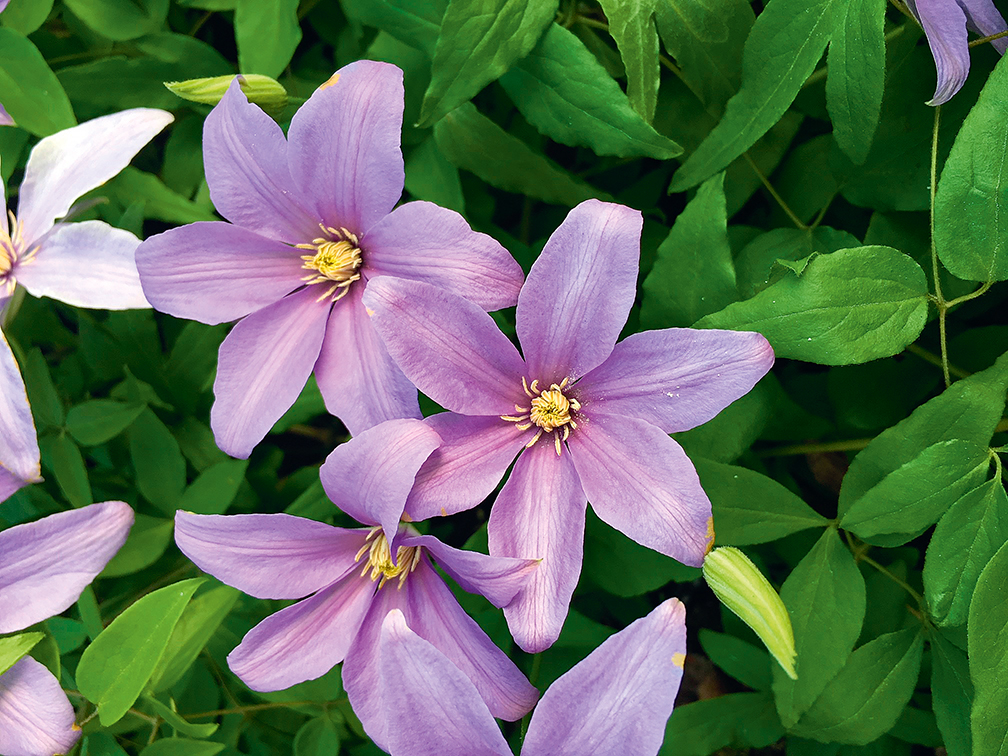
Best perennials for containers
Providing long-term colour and texture, many perennials are perfect for container gardening, but most will need to be lifted and divided after a couple of years. We like Achillea, Bergenia, Ferns, Hosta, Phlox, and Sedum.

Best trees for containers
Yes, trees can be grown in containers! Acers and citrus trees are very popular and do well in large container for many years, but you could even have success with some species of fig, cherry, and acacia – look out for 'dwarf' or 'suitable for containers' on the plant description.
7. Watering and feeding
Plants in pots have less access to moisture and nutrients as opposed to those in the ground so you need to make up for this, especially in hot weather. You can water at any time of day (forget the old myths about lunchtime time sun scorching your plants, this doesn't actually happen), but mornings are best as this will help your plants stay hydrated throughout the day. Avoid watering plants after dark as this makes them vulnerable to slugs and root rot.
When it comes to feeding, many vegetables, in particular, will benefit from the addition of slow-release fertilizer.
They will need a big drink of water, so a watering can will do for one or two pots, but you will need the best garden hose to tackle a whole container garden. For low admin watering, try creating your own self watering system.
8. Repotting
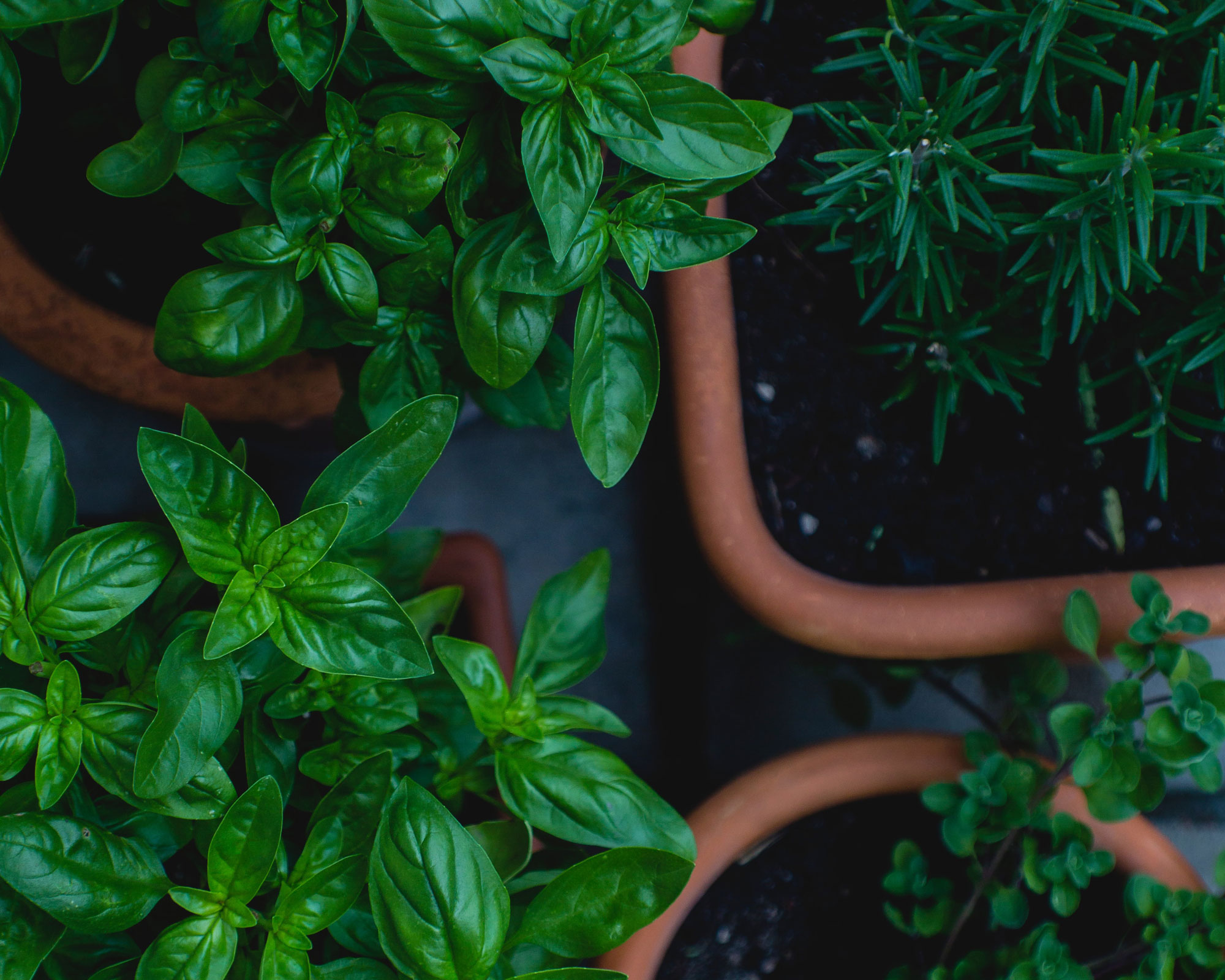
Not all container-grown plants require repotting. Roses, for example, hate being disturbed and will likely die if you repot them. Citrus trees can also do well in the same container for many years, provided it's large enough.
Faster-growing plants, however, will need repotting. This applies to potted hydrangeas and most other shrubs, as well as bamboo and climbing plants like jasmine. If you plant looks uncomfortably big for its pot, it probably is, so give it a new pot that's at least a third larger.
9. Protecting against extreme temperatures
Container plants are vulnerable to temperature extremes: in winter the compost will freeze more quickly and more thoroughly than the soil in the ground, and it will also heat up and dry out rapidly during the summer months.
It's easy to protect plants from frost when they're in pots – just take them inside or put in the greenhouse when it's really cold, or, failing that, wrap them in bubble wrap.
10. The basic design rules
The following guidelines will help you to achieve the best results, either by combining separate plants in their own pots, or by bringing together a range in larger containers:
- Tallest at the back, shortest at the front. This is a basic principle for traditional border planting and a good starting point for containers, too. In small spaces it ensures all plants can be seen and the shorter forms hide the sometimes less attractive lower stems of taller ones.
- Rely on mass. Plants fall into one of three basic categories: tall and upright, medium-sized mass, small and spreading. If most of the plants used fall into the middle category, they will give your container combinations weight and physical presence.
- Limit the drama. Don’t overdo plants that draw attention to themselves, notably those with height, or dramatic or large leaves. Check that their stems and leaves have sufficient space.
- Pack them in. Seasonal plantings, such as annuals, look best if they are exuberant and fulsome. Closely packed annuals in a container will need regular watering and feeding.
- Less is more. Paring back the number of shapes, shades and species will create a more sophisticated look in a container.
- Remember the little ones. Small spreading plants, including alpines and succulents, also need full sun, so pot them up separately and ensure they are not overshadowed in the container.
Container garden ideas
Your options are fairly endless when it comes to displaying your container garden.
'The next step is to get some inspiration, by looking in books, online and even over your neighbor’s fence', says McTernan.
These are some of our favorite container garden looks to inspire yours.
1. Enhance basic pots with willow wheels
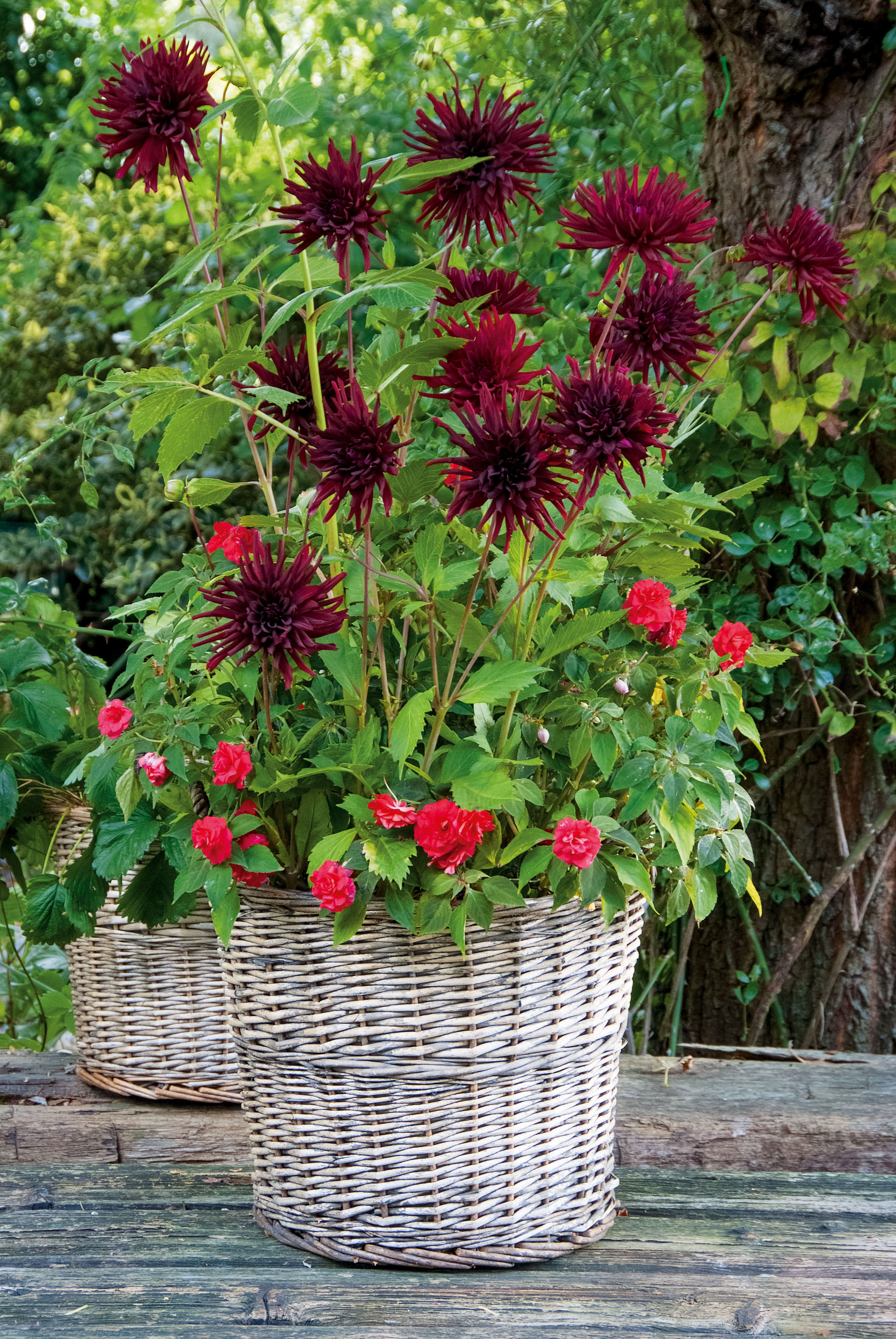
Willow can be used to conceal an unattractive or purely functional plastic container, and the life of the willow will also be prolonged because it is not in contact with wet compost. Just make sure it is a willow skirt rather than a full willow pot so the bottom doesn't become sodden.
2. Keep it small and succulent
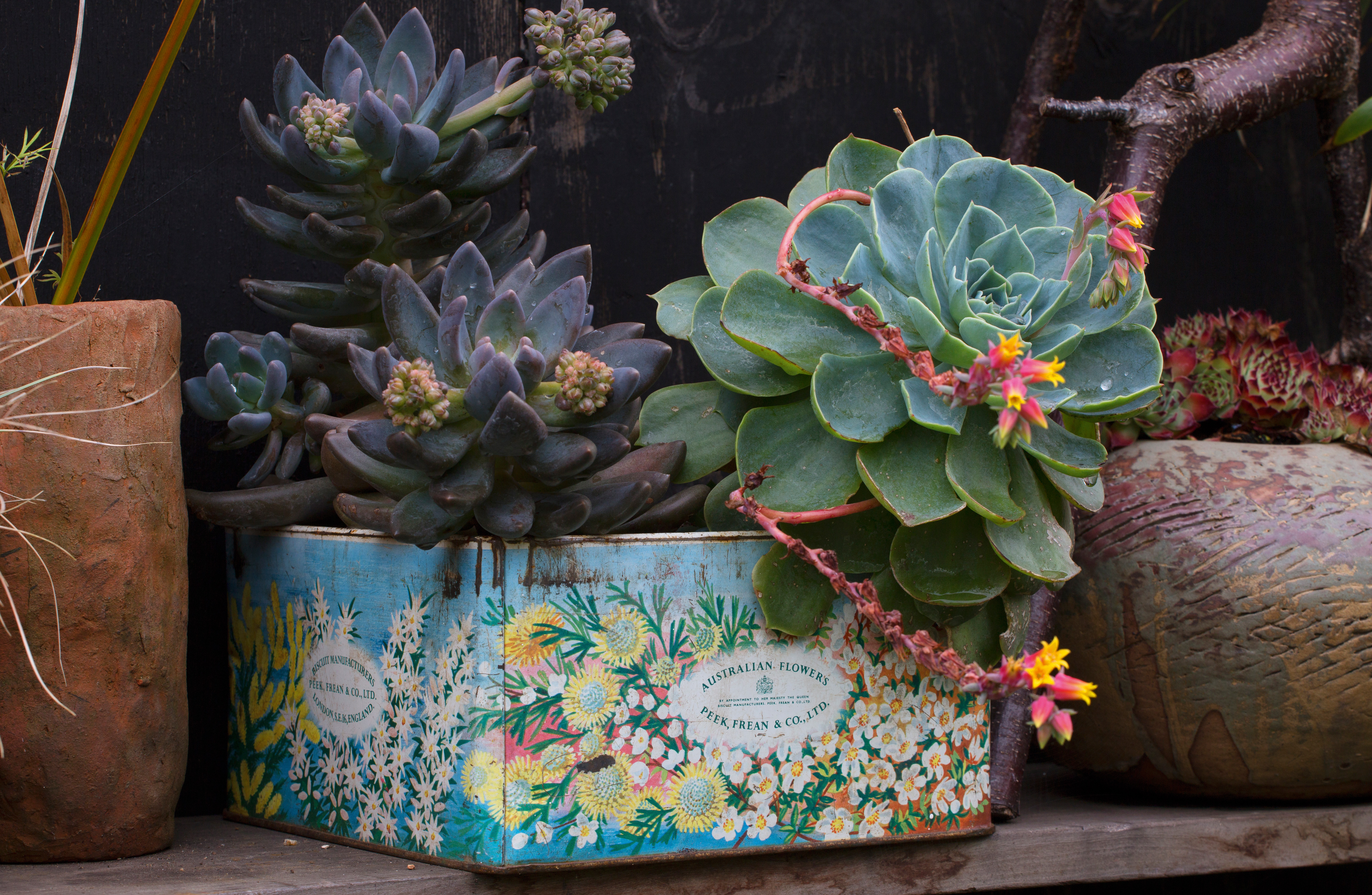
Succulents are super hardy (and cute) so will withstand all the small, odd spots and likely fluctuations in temperature also. They are a failsafe option for all beginner container gardeners. They are the perfect indoor garden idea that you can take outside in better weather to enjoy in your outdoor living space.
3. Play with height
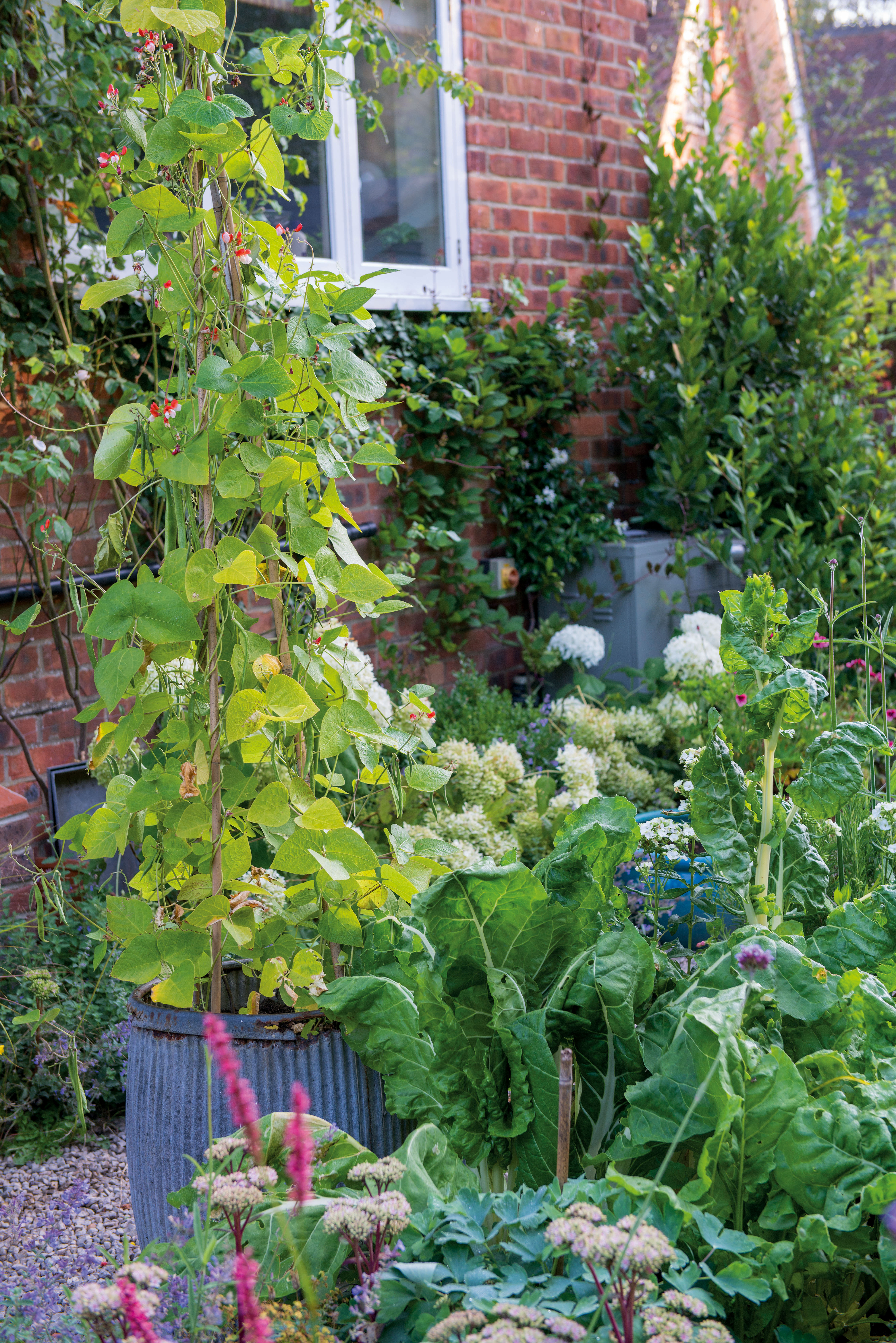
Mixing tall dominating plants in large containers with small plants that are lower to the ground will add interest and enhance the size of a small garden spot too. In this example, beans are grown up a suppory to add height so the look is pretty and practical for the veg gardener.
4. Use your vertical space

Where space is very limited, a planting display in hanging pots will provide a welcome pop of color to an otherwise plain wall or corner. Or construct a planter box to group them all together on a garden wall. You could even create a living wall with containers, if you wanted to.
5. Stick with terracotta for an earthy feel
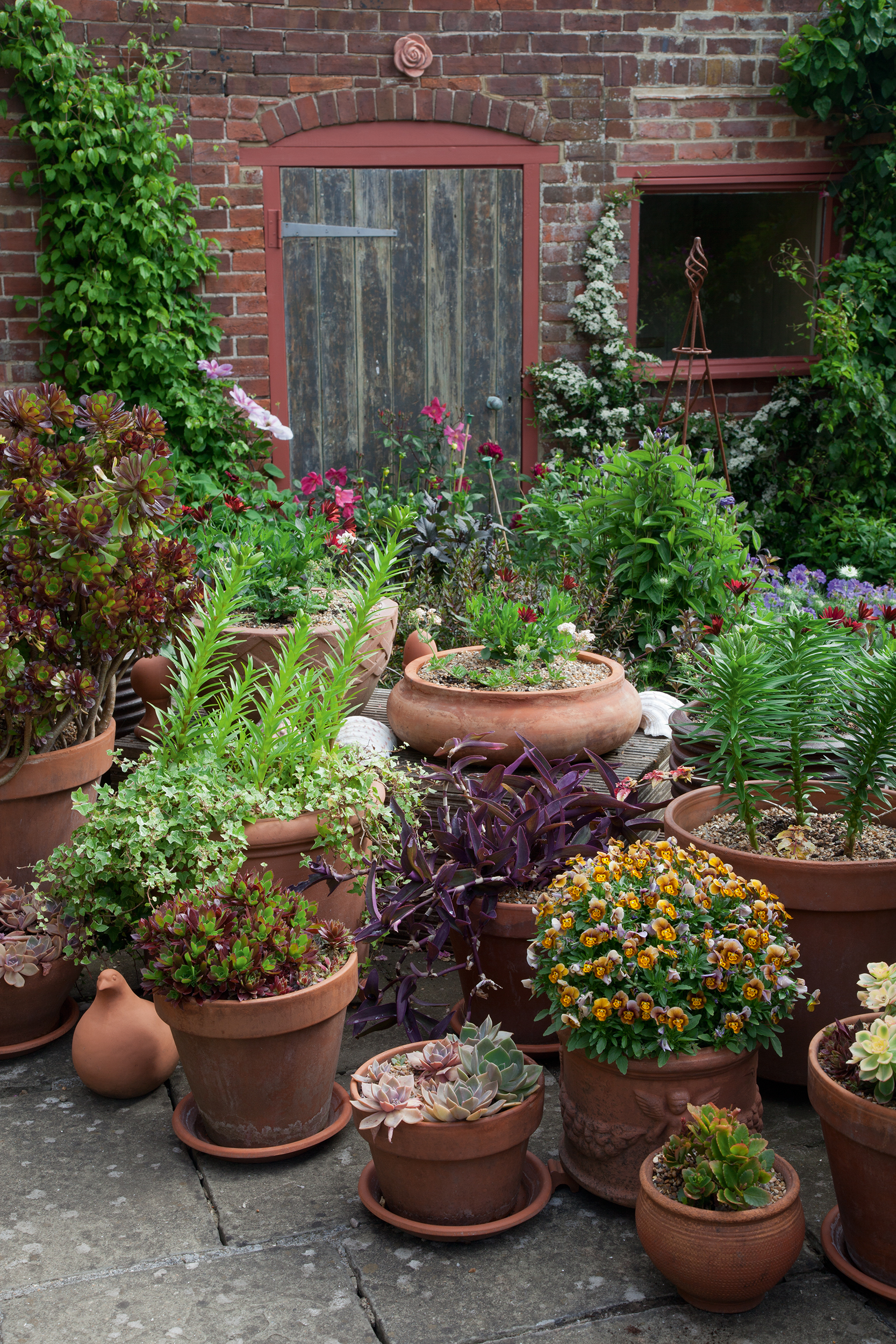
A container garden looks so natural and unified with terracotta. Choose different sized containers for added interest and keep any cutesy terracotta accessories close by also.
6. Use container gardening to add punchy colour
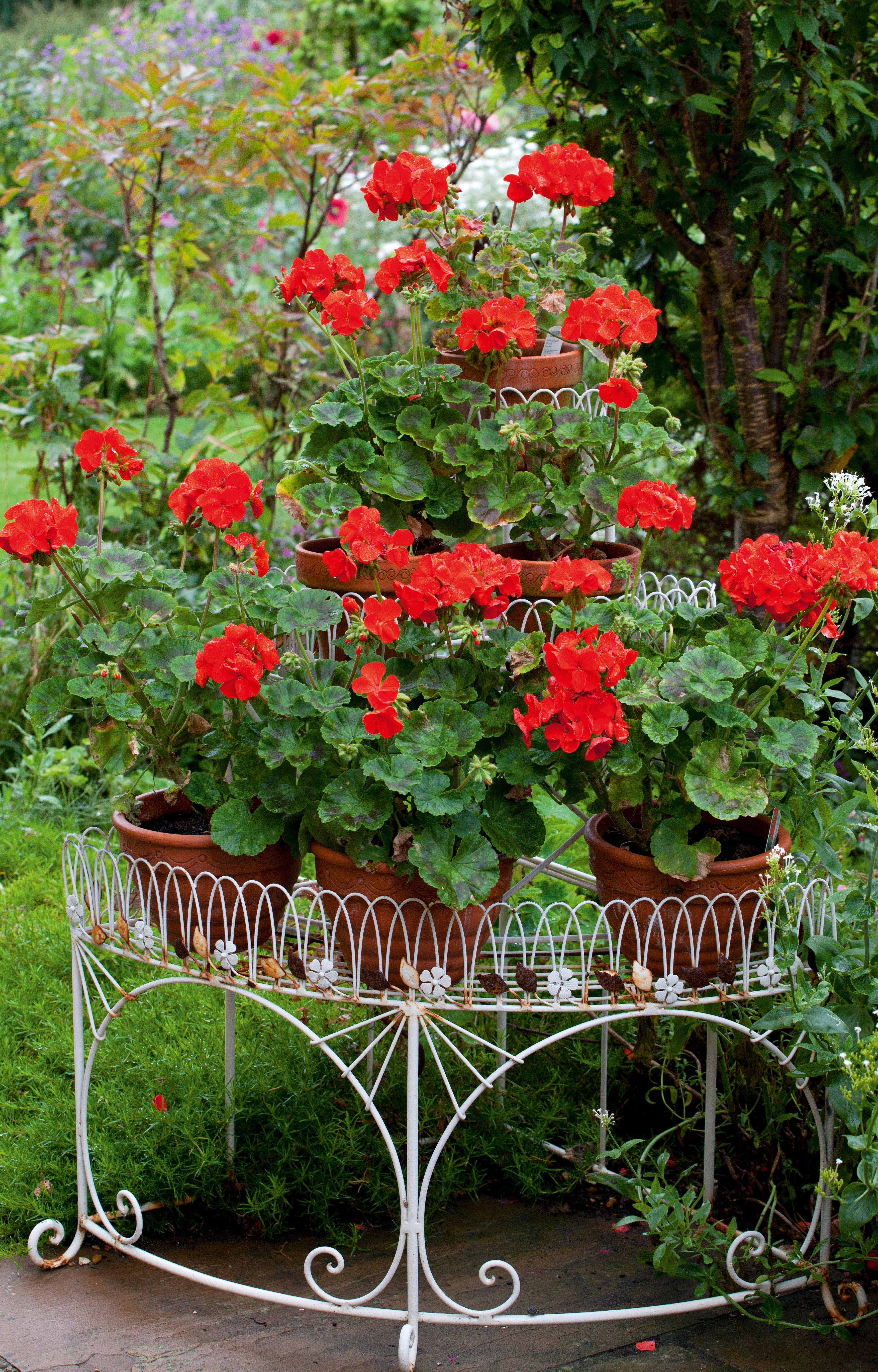
A garden container planted with just one type of brightly coloured flower can be used to instantly update the colour scheme of your garden. Use seasonal planting to introduce a bit more unusual colour in the spring and summer, or plant flowering perennials for reliable flowering year after year. There are so many plants to choose from!
7. DIY a container garden on your balcony

If you're starting a balcony garden, you can get away with using a mixture of garden plants and house plants – just remember taking anything non-hardy in when the frosts arrive in winter. Sunny balconies are the perfect spaces for growing pelargoniums and other plants that don't do well in cold weather, because the temperature on a balcony at night will typically be higher than on the ground.
If your balcony is north-facing, you can have great success growing evergreens like ivy in hanging garden containers.
8. Displays containers on tiered shelves
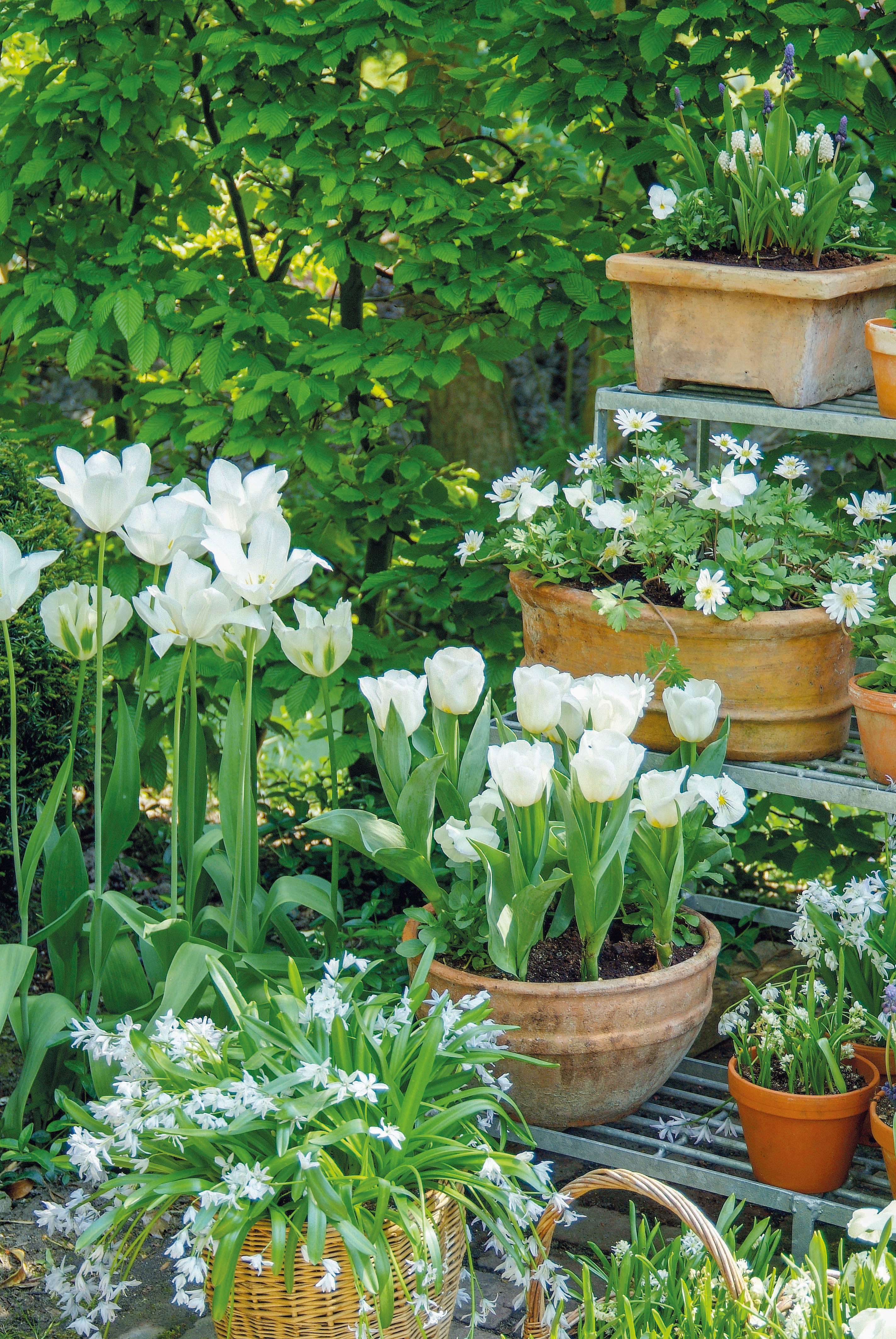
Use shelving so that you can change the display of container plants, bringing those at their flowering peak to the front, or altering the colour combinations to suit the seasons. This helps pack a lot of plants into a smaller footprint and offers and accessible option that can be easier to care for.
9. Or on garden seating

Using all the levels of your garden will make for an eclectic display, we love combining containers with garden seating ideas to add even more colour and energy to an outdoor space.
10. Mix ornamental plants for texture
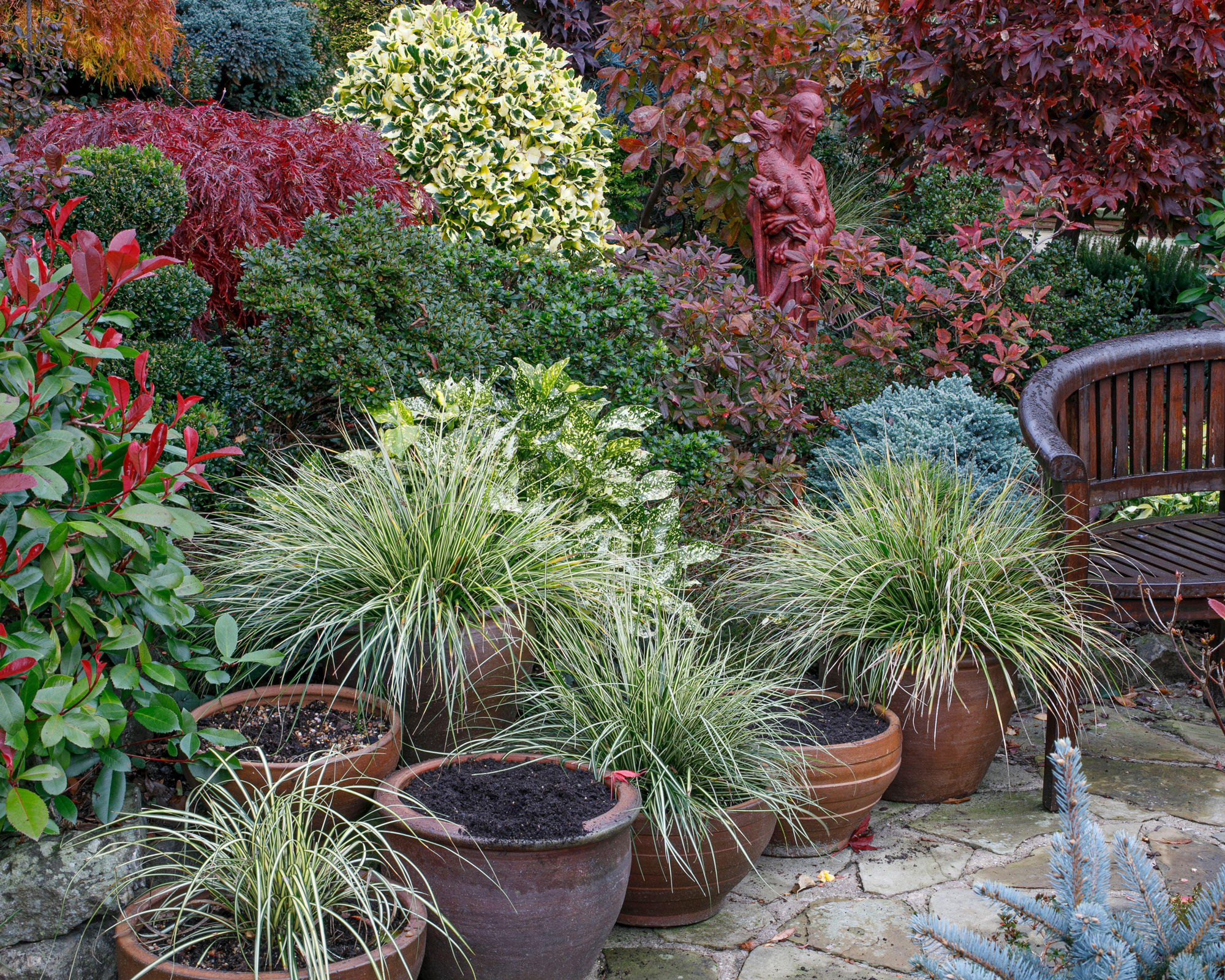
Add texture to even a small corner of your outdoor space with bushy heather, grasses, acers, and alpine plants for a little contrast but lots of volume. The more different textures you combine, the more opulent the effect will be.
11. Less is more in smaller spaces
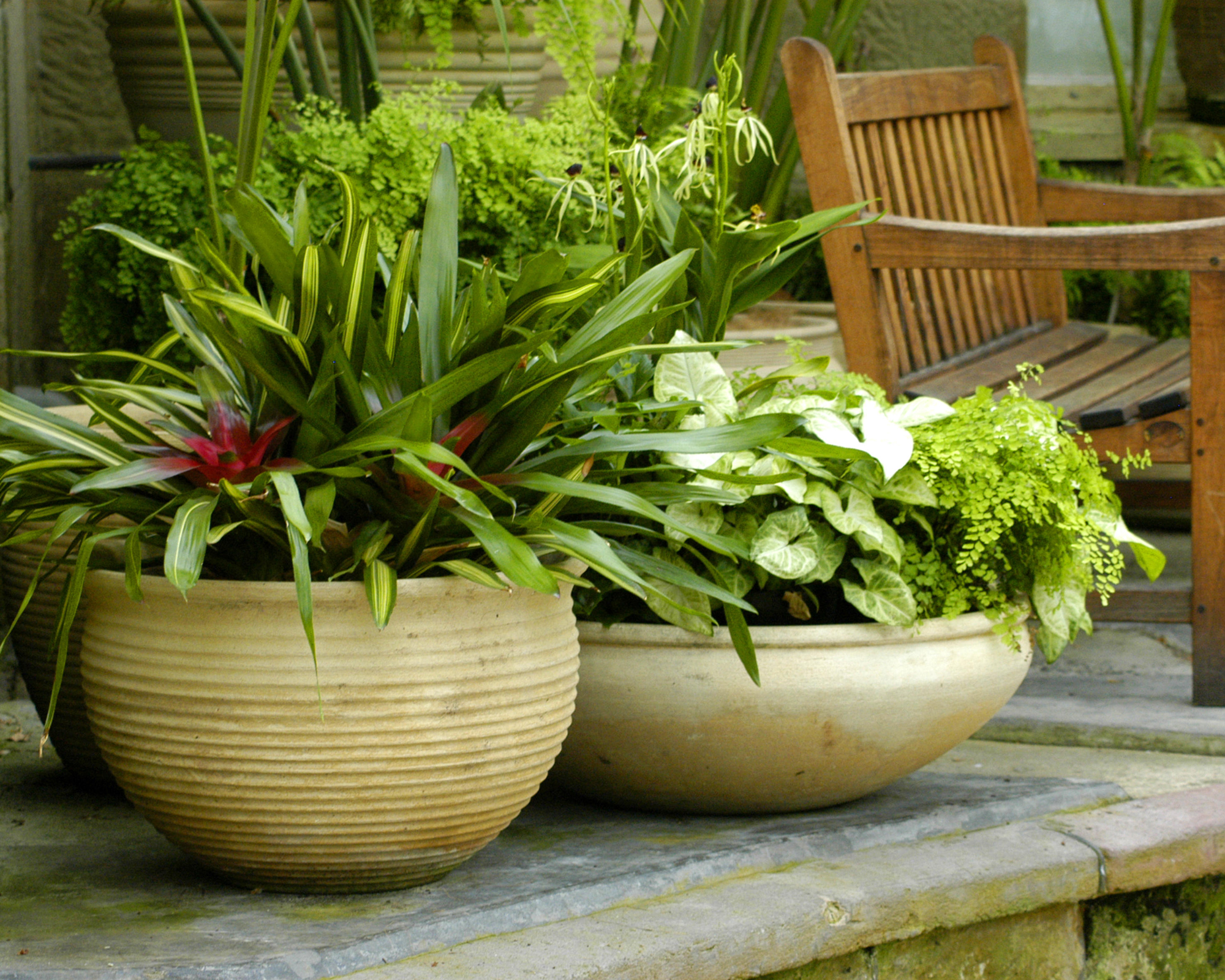
If you want to add some containers as part of your patio ideas and are short on space, go for a few large containers rather than lots of smaller ones. You'll instantly achieve a clean, contemporary look that's very on-trend and low-maintenance.

How can I start a container garden on a budget?
McTernan's advice is: 'Be realistic about your budget – a container garden is a good idea but might require a bit of imagination to fill it with recycled receptacles if numerous (and expensive) shop-bought containers are out of the question.
Raised beds are a good option if budgets are tight, either making them from recycled, free materials or buying inexpensive wood. They don’t have to be raised to great heights – mine are 30cm or so high, which was just enough to allow me to add organic matter and some good topsoil and to keep them topped up with rich, nutritious soil. You can put them on hard ground (paving or concrete), but make sure they’re deep enough to provide ample soil for roots to grow.
'Alternatively, you can put them directly on grass and, of course, bare earth. If your raised beds are deeper than 50cm, add a layer of hardcore to help with drainage – this also helps reduce the amount of soil you need to use. You will also need to dig foundations if you’re building brick or stone walls higher than 20cm.'
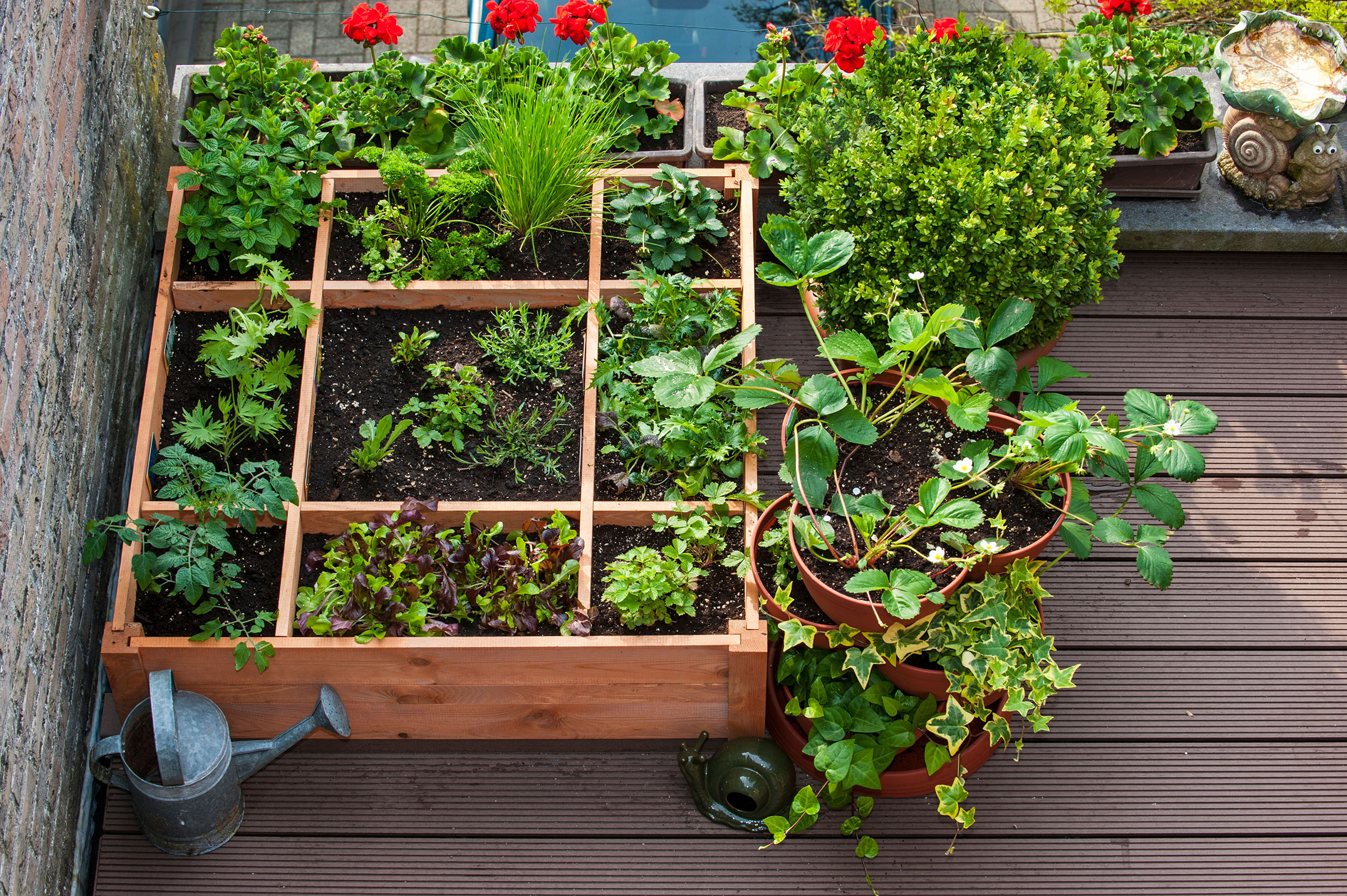
Can I start a container garden in a really tiny backyard?
Yes, and McTernan advises 'using design to solve practical issues involving space.' Foe example, 'think pleached or lollipop-shaped trees to allow for growing space beneath them rather than designing around something that is really just a gimmick (think planting in wellies and vintage cans of Heinz tomato soup).'
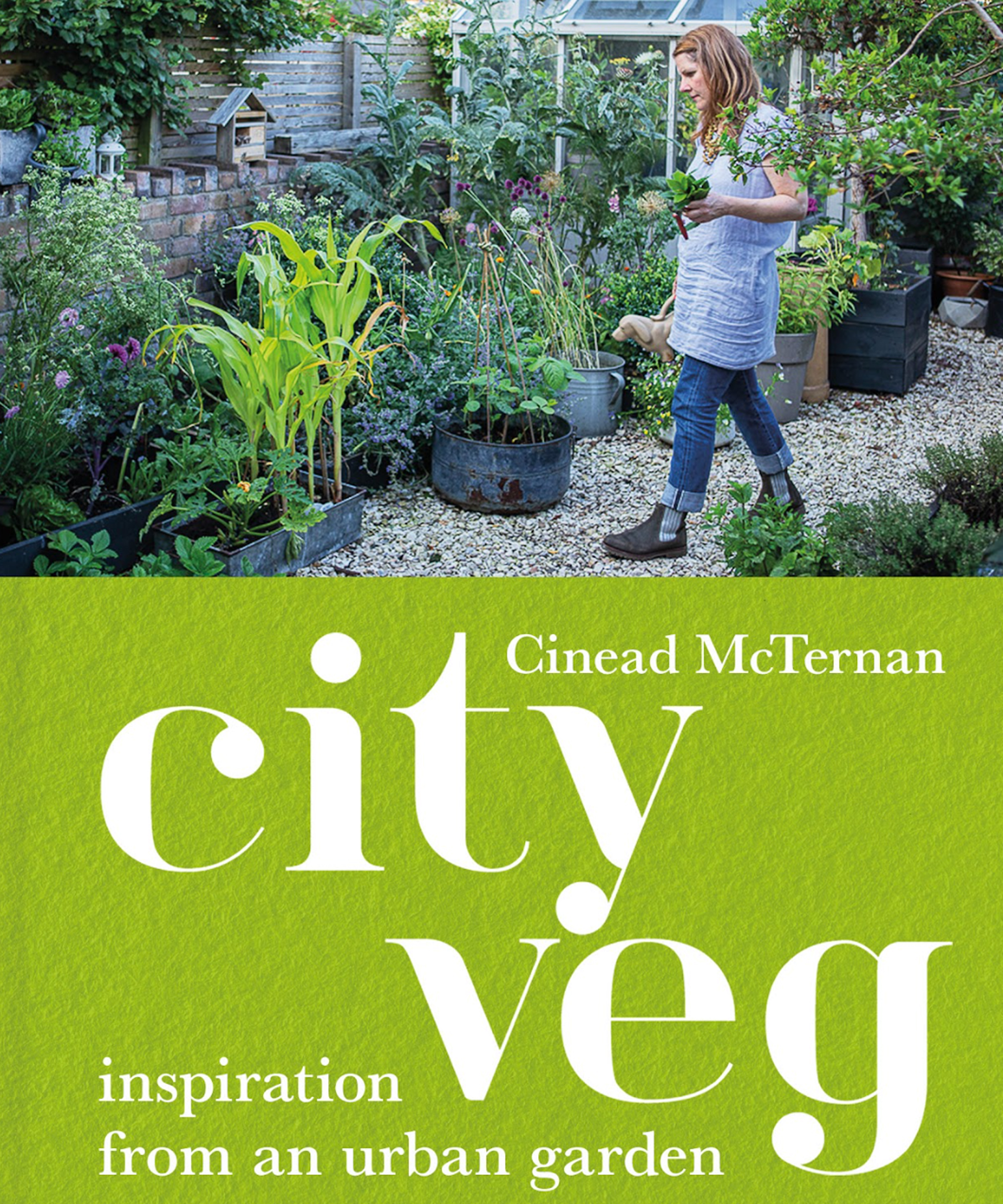
City Veg: Inspiration from an Urban Garden by Cinead McTernan (Bloomsbury Wildlife) is published in hardback and ebook and is available from Amazon
We told you you could container garden it like a pro.
- Camille Dubuis-WelchFormer Deputy Editor
- Anna K. Cottrell